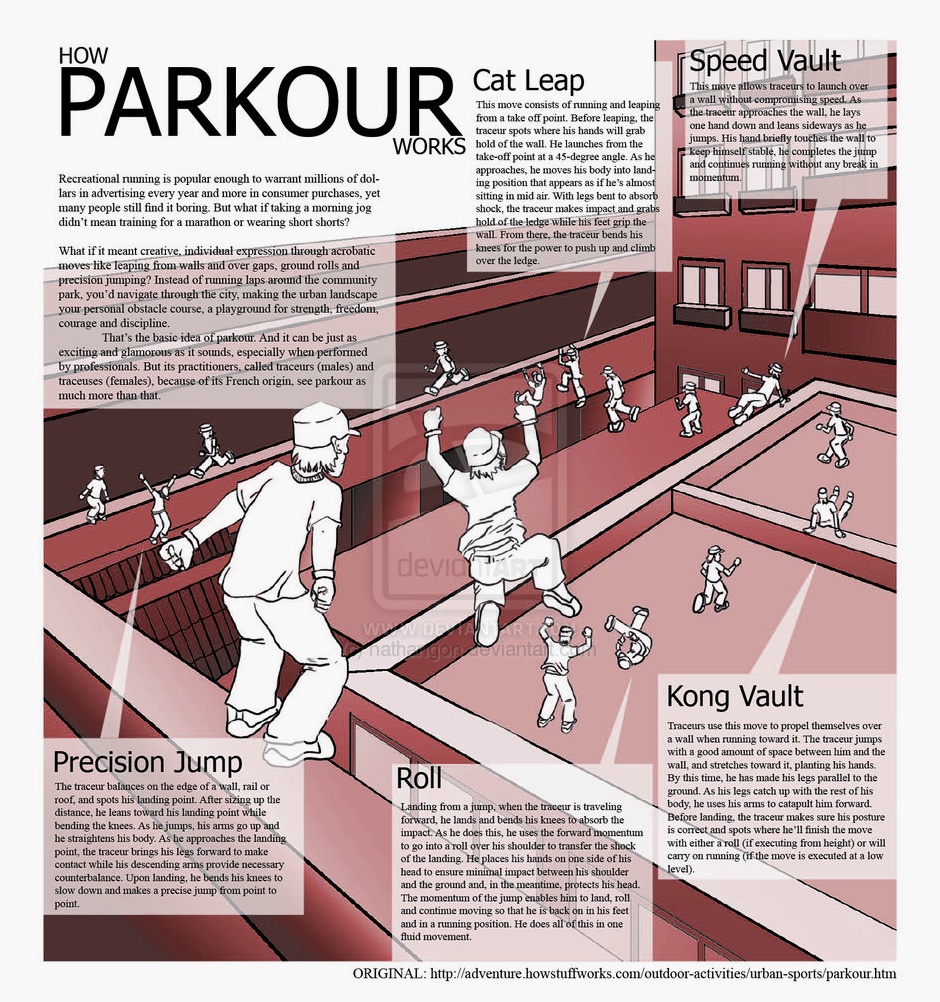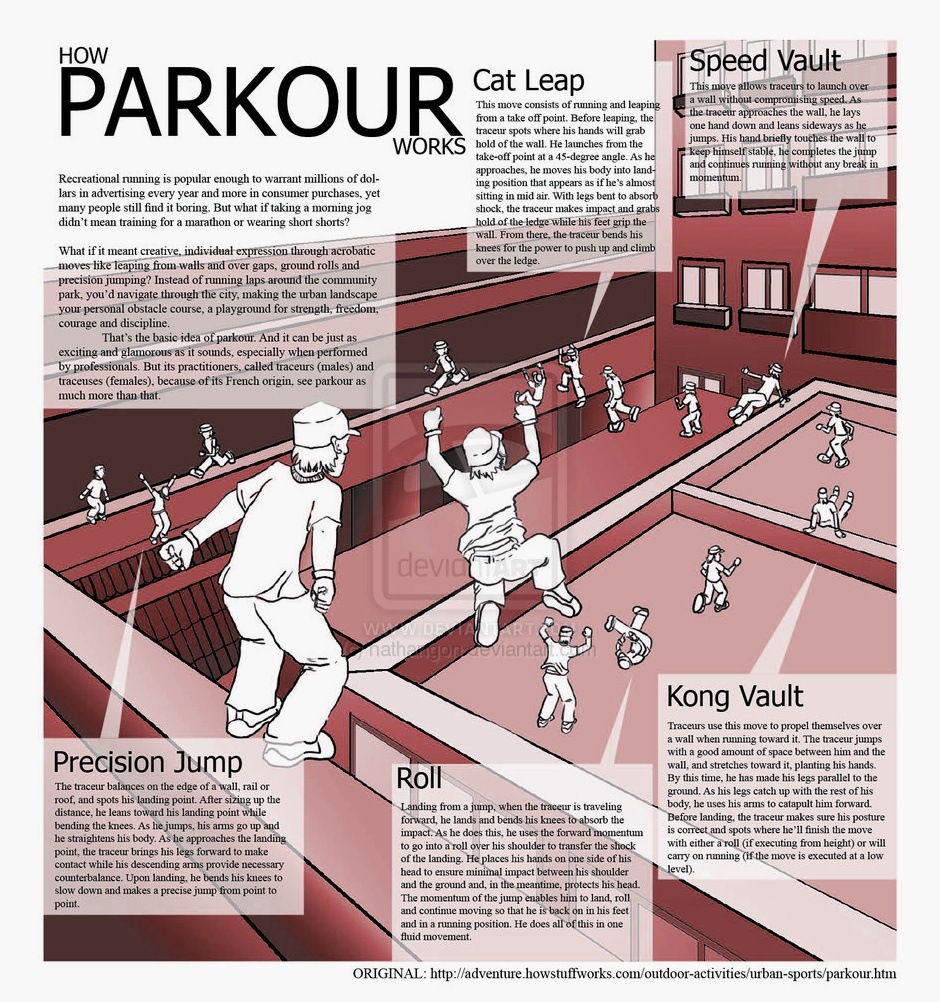Parkour is as moldable as a traceur’s creativity and physical capabilities allow. For many traceurs, parkour is a gateway to freedom from social constraints as they “free their minds” from society’s messages of how public spaces and their body are to be used. The fact that no equipment other than a pair of trainers and an open mind are needed makes it all instantly accessible. With that said, the number of possible movements is endless, but here are the basics:
Parkour Cat Leap
 This move consists of running and leaping from a take off point. Before leaping, the traceur spots where his hands will grab hold of the wall. He launches from the take-off point at a 45-degree angle. As he approaches, he moves his body into landing position that appears as if he’s almost sitting in mid air. With legs bent to absorb shock, the traceur makes impact and grabs hold of the ledge while his feet grip the wall. From there, the traceur bends his knees for the power to push up and climb over the ledge.
This move consists of running and leaping from a take off point. Before leaping, the traceur spots where his hands will grab hold of the wall. He launches from the take-off point at a 45-degree angle. As he approaches, he moves his body into landing position that appears as if he’s almost sitting in mid air. With legs bent to absorb shock, the traceur makes impact and grabs hold of the ledge while his feet grip the wall. From there, the traceur bends his knees for the power to push up and climb over the ledge.
Parkour Roll
 Landing from a jump, when the traceur is traveling forward, he lands and bends his knees to absorb the impact. As he does this, he uses the forward momentum to go into a roll over his shoulder to transfer the shock of the landing. He places his hands on one side of his head to ensure minimal impact between his shoulder and the ground and, in the meantime, protects his head. The momentum of the jump enables him to land, roll and continue moving so that he is back on in his feet and in a running position. He does all of this in one fluid movement.
Landing from a jump, when the traceur is traveling forward, he lands and bends his knees to absorb the impact. As he does this, he uses the forward momentum to go into a roll over his shoulder to transfer the shock of the landing. He places his hands on one side of his head to ensure minimal impact between his shoulder and the ground and, in the meantime, protects his head. The momentum of the jump enables him to land, roll and continue moving so that he is back on in his feet and in a running position. He does all of this in one fluid movement.
Parkour Precision Jump
 The traceur balances on the edge of a wall, rail or roof, and spots his landing point. After sizing up the distance, he leans toward his landing point while bending the knees. As he jumps, his arms go up and he straightens his body. As he approaches the landing point, the traceur brings his legs forward to make contact while his descending arms provide necessary counterbalance. Upon landing, he bends his knees to slow down and makes a precise jump from point to point.
The traceur balances on the edge of a wall, rail or roof, and spots his landing point. After sizing up the distance, he leans toward his landing point while bending the knees. As he jumps, his arms go up and he straightens his body. As he approaches the landing point, the traceur brings his legs forward to make contact while his descending arms provide necessary counterbalance. Upon landing, he bends his knees to slow down and makes a precise jump from point to point.
Parkour Kong Vault
 Traceurs use this move to propel themselves over a wall when running toward it. The traceur jumps with a good amount of space between him and the wall, and stretches toward it, planting his hands. By this time, he has made his legs parallel to the ground. As his legs catch up with the rest of his body, he uses his arms to catapult him forward. Before landing, the traceur makes sure his posture is correct and spots where he’ll finish the move with either a roll (if executing from height) or will carry on running (if the move is executed at a low level).
Traceurs use this move to propel themselves over a wall when running toward it. The traceur jumps with a good amount of space between him and the wall, and stretches toward it, planting his hands. By this time, he has made his legs parallel to the ground. As his legs catch up with the rest of his body, he uses his arms to catapult him forward. Before landing, the traceur makes sure his posture is correct and spots where he’ll finish the move with either a roll (if executing from height) or will carry on running (if the move is executed at a low level).
Parkour Speed Vault
 This move allows traceurs to launch over a wall without compromising speed. As the traceur approaches the wall, he lays one hand down and leans sideways as he jumps. His hand briefly touches the wall to keep himself stable, he completes the jump and continues running without any break in momentum.
This move allows traceurs to launch over a wall without compromising speed. As the traceur approaches the wall, he lays one hand down and leans sideways as he jumps. His hand briefly touches the wall to keep himself stable, he completes the jump and continues running without any break in momentum.
sources: howstuffworks & deviantart
Sport and Motor Tagged: freerunning infographic moves parkour tracuer




27 comments
Comments are closed.